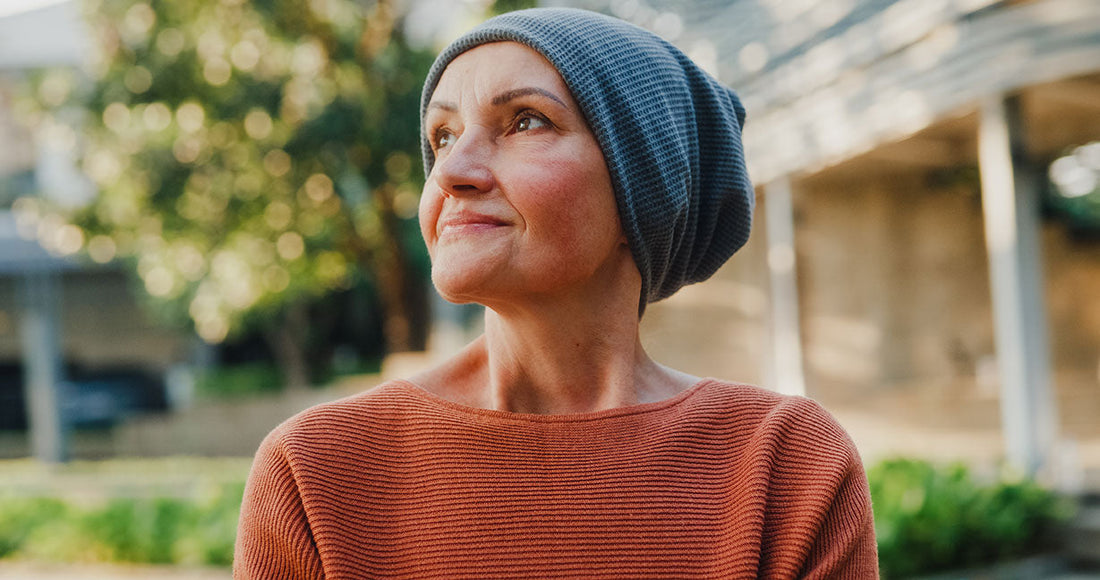Introduction: The Importance of Choosing the Right Cancer Hat
When we think about finding the new stylish “it” product for the year, we likely don’t expect that search to include the perfect hat for a newly hairless head. But if you’re reading this, you or someone you love has faced a Cancer diagnosis. If your (or your loved one’s) cancer treatments include chemotherapy, like me, you might be particularly concerned about hair loss and preparing for that jarring side effect of many chemo drugs. Before undergoing chemo, I really didn’t look sick, and I was most fearful (and sad and mad!) that once my hair started to fall out, people would be able to tell “something was wrong.” I purchased wigs and hats in preparation of that time, and with input from our community of fellow cancer patients and survivors, we’ve put together some information about head coverings to get you through the jarring (and often chilly!) period that you or your loved one might be without hair.
Table of Contents
- What to Look for in a Cancer Hat
- Why Should Cancer Patients Buy a Chemo Hat?
- Chemo Headwear Size Guide
- Exploring 10 Types of Chemo Hats for Cancer Patients
- 5 Must-Have Basic Headwear Items
- Learning from Common Beginners' Mistakes
- Style, Color, and Accessorizing Your Cancer Hat
- Caring for Your Cancer Hat
What to Look for in a Cancer Hat
Finding the right hat is a personal choice, so while this list of things to look for is good to keep in mind, we encourage you to ultimately go for one that makes you feel comfortable and confident.
- Soft Material: Choose a hat made of soft fabric like cotton or bamboo. This will be gentle on your sensitive skin.
- Breathable: Look for a hat that allows air to flow through. This helps to keep your head cool and comfortable.
- Full Coverage: Find a hat that covers your entire head to protect your scalp from the sun and keep you warm.
- Seamless Inside: Check for a hat with no rough seams inside. This prevents irritation on your scalp, which might be sensitive after chemotherapy.
- Easy to Put On: Choose a hat that you can easily put on and take off, especially if you're feeling tired or weak.
- Color and Style: Select a hat in a color and style you like. Feeling good about how you look can boost your spirits.
- Lightweight: Opt for a lightweight hat so it doesn't feel heavy on your head, making it more comfortable for everyday wear.
- Easy to Clean: Pick a hat that is easy to clean and maintain, so you can keep it fresh and hygienic.
- UV Protection: If you'll be spending time outdoors, make sure the hat provides protection from the sun's harmful UV rays.
Understanding the Purpose: Why Should Cancer Patients Buy a Chemo Hat?
Here are some reasons you might consider buying a chemo hat.
- Comfort: Hats provide a soft and cozy layer on your head, making it more comfortable, especially if your scalp is sensitive after chemotherapy.
- Warmth: A hat keeps your head warm, which is important as chemotherapy might make you feel cooler than usual.
- Protection from the Sun: Wearing a hat shields your scalp from the sun's rays, preventing sunburn and protecting sensitive skin.
- Style and Confidence: Hats come in various styles and colors, allowing you to express your personality and feel more confident about your appearance.
- Privacy: Some people prefer to keep their experience private. A hat provides a bit of privacy and control over what others see.
- Versatility: Hats are versatile accessories. You can wear them indoors or outdoors, depending on your comfort and style.
- Easy to Use: Hats are easy to put on and take off, requiring minimal effort, which can be helpful during periods of fatigue.
- Emotional Support: Wearing a hat might bring a sense of normalcy and routine during a challenging time, offering emotional support.
- Expression of Personal Style: Choosing a hat that matches your personal style allows you to express yourself, even when facing health challenges.
Remember, it's essential to find a hat that feels right for you and meets your specific needs during this time.
Determining the Perfect Fit: Chemo Headwear Size Guide
Choosing the best headwear for chemo patients is crucial for comfort and confidence after hair loss during chemotherapy. To find the perfect fit, start by measuring your head circumference. Using a flexible measuring tape, wrap it around your head, just above your eyebrows and ears. Take note of this measurement as it serves as a reliable guide for selecting the right size. After hair loss, factors such as the sensitivity of your scalp become pivotal. Opt for headwear made from soft materials with no rough seams inside to ensure a gentle touch on your sensitive skin.
Understanding the crown-height and crown-length dimensions is equally important. The crown height refers to the distance from the base of the headwear to the top, ensuring it adequately covers your head. Crown length, on the other hand, determines how much of your neck and forehead the headwear shields. By considering these factors, you can tailor your choice to both style and functionality, ensuring a chemo headwear size that not only fits snugly but also provides the comfort and coverage needed during this challenging time.
Exploring 10 Types of Chemo Hats for Cancer Patients
Here are some different types of head coverings used by patients undergoing cancer treatments like chemotherapy.
- Chemo Caps: Soft and lightweight, chemo caps are snug-fitting head coverings that provide warmth and comfort during and after chemotherapy.
- Chemo Beanies: Similar to caps, chemo beanies are close-fitting and often made from soft materials, offering a stylish and comfortable option for covering the head.
- Chemo Scarves: Scarves are versatile head coverings that can be tied in various ways to provide full or partial coverage. They come in a variety of fabrics, colors, and patterns. I’m not going to lie, I never mastered tying scarves properly during my own chemo period, but I have seen some beautifully executed scarf wearers (that I secretly envied!).
- Cancer Turbans: Turbans designed for cancer patients are stylish and easy to wear. They provide full coverage and come in different materials, including soft fabrics suitable for sensitive skin.
- Headwraps: Headwraps are wide pieces of fabric that can be wrapped around the head in different styles, offering a customizable and fashionable option for covering the head.
- Bamboo Hats: Hats made from bamboo fabric are soft, breathable, and moisture-wicking, providing a comfortable and eco-friendly choice for chemo patients.
- Sleep Caps: Designed specifically for nighttime use, sleep caps are soft and gentle, providing comfort during sleep and helping to keep the head warm.
- Pre-tied Scarves: For convenience, pre-tied scarves come with attached headbands or elastic for easy wear, providing a stylish and hassle-free option. (Clearly, I missed the memo about this during my own treatments!)
- Liner Caps: These caps are worn underneath other head coverings to provide an additional layer of comfort and protect the scalp. If you choose to wear a wig during your chemo treatments, these liners can be particularly helpful.
- Bandanas: Bandanas offer a lightweight and versatile option for chemo patients, allowing them to tie it in various styles for different looks.
5 Must-Have Basic Headwear Items Every Cancer Patient Should Consider
When I was going through chemo and lost my hair, I had a variety of head coverings at the ready. In talking with our community, here are 5 must-have headwear items that you might find helpful.
- Chemo Caps or Beanies: Soft and comfortable caps or beanies provide essential warmth, cover, and comfort for the head. They are versatile and can be worn indoors or outdoors, offering a simple yet effective solution for maintaining warmth and style.
- Chemo Scarves: Scarves are incredibly versatile and can be tied in different styles to provide coverage and variety. Choose soft, breathable fabrics to ensure comfort, and consider having a few in various colors and patterns to match different outfits.
- Cancer Turbans: Turbans are stylish and easy to wear, providing full coverage for the head. They come in various designs and materials, offering a fashionable and comfortable alternative for cancer patients.
- Sleep Caps: Designed specifically for nighttime use, sleep caps keep the head warm and comfortable during sleep. Opt for soft materials to ensure a gentle touch on the scalp.
- Bamboo Hats: Hats made from bamboo fabric are soft, breathable, and moisture-wicking. These hats provide comfort and style, making them a must-have basic headwear item for cancer patients, particularly those with sensitive skin.
These basic headwear items offer a combination of comfort, style, and practicality, addressing the various needs that cancer patients may have during and after treatment. It's advisable to have a selection of these items to cater to different situations and preferences.
Making Informed Choices: Learning from Common Beginners' Mistakes
Here are some common mistakes to avoid when looking for head coverings or chemo hats to use during cancer treatments.
Not Shopping at Specialized Stores: One common mistake is not exploring specialized stores that cater specifically to cancer patients. These stores often offer a wider range of chemo headwear designed for comfort and style, ensuring that the needs of individuals undergoing treatment are met.
Ignoring Itchy Seams and Stitches: Overlooking the importance of seamless construction can lead to discomfort. Itchy seams and stitches may irritate a sensitive scalp, so it's crucial to choose hats without rough seams inside. Opt for headwear designed with the comfort of chemotherapy patients in mind.
Neglecting Material Considerations: Different materials offer varying levels of comfort and breathability. Bamboo and silk, for example, are soft, hypoallergenic, and moisture-wicking, making them excellent choices for chemo hats. Pay attention to material considerations to ensure that the hat is gentle on sensitive skin.
Limiting Color Choices to Black and Gray: While black and gray are classic choices, limiting oneself to these colors might overlook the mood-lifting and confidence-boosting effects of vibrant or favorite colors. Choosing a variety of colors can enhance the emotional well-being of individuals going through chemotherapy, allowing them to express their style and personality. (This, coming from a woman - me - who wears a black shirt each day, so take this one with a grain of salt.)
By avoiding these common mistakes and considering factors like specialized stores, seam comfort, materials, color choices, head size, and style preferences, individuals can make more informed decisions when selecting chemo hats that meet their unique needs during cancer treatment.
Style, Color, and Accessorizing Your Cancer Hat
When picking a hat during chemotherapy, it's essential to choose a style that makes you feel good and confident. Consider selecting colors that complement your skin tone and bring out your personality. Bright and cheerful colors can lift your spirits. Additionally, adding accessories like scarves or small hairpieces can enhance the overall look and make the hat uniquely yours. These accessories not only add a touch of personal style but also help you express yourself during a challenging time. Experiment with different combinations to find the most flattering hat type that suits your preferences, making you feel comfortable and stylish as you navigate through the cancer experience.
Caring for Your Cancer Hat
Taking care of your cancer hat is important for maintaining comfort and style throughout your journey. Choosing hats made from recommended fabrics such as soft bamboo or breathable cotton can offer comfort, especially if your scalp is sensitive. Ensure the right fit by selecting hats with adjustable features to accommodate changes in head size during treatment. Styling tips can vary depending on the hat type—experiment with scarves, hairpieces, or different tying techniques to personalize your look. Proper care involves gentle handwashing with mild detergent to maintain the hat's integrity and hygiene. Allow the hat to air dry to prevent any potential damage. When not in use, store your hats in a cool, dry place to preserve their shape and keep them ready for use. By following these care tips, you can ensure that your cancer hat remains a source of comfort, confidence, and personal expression throughout the cancer experience.
Conclusion and Takeaways
In conclusion, choosing the right cancer hat is not just about functionality but also about expressing your personal style and maintaining confidence during challenging times. The journey through chemotherapy and hair loss can be emotionally overwhelming, but finding a hat that suits your comfort and fashion preferences can uplift your spirits. The list of considerations, from selecting soft materials to exploring various hat types and avoiding common mistakes, serves as a guide to make informed choices. Remember that each person's experience is unique, so it's encouraged to find a hat that resonates with your individual style and needs. As you embrace different head coverings and styles, know that your choice reflects your strength, resilience, and the beauty of expressing yourself during a challenging time. Because we all need to find those little glimmers of light during the otherwise crappy cancer experience.
Also Read: How Bad Is TCHP Chemo?
Comments, Questions, and Feedback
The Manta Cares team is composed of cancer survivors, caregivers and oncologists - so we truly understand the challenges that come with a cancer diagnosis because we’ve been there. We are here to walk with you as you go through your own cancer experience. Please don’t hesitate to reach out with any questions. Be sure to subscribe to our newsletter and check out our free resources like our Chemotherapy Checklist for Caregivers, Financial Checklist for Cancer Treatment and more. We also put out a bi-weekly podcast called the Patient from Hell to educate, empower and hopefully inspire you as you go through this crappy experience. You can listen on Spotify, Apple Podcasts, YouTube or anywhere you listen to podcasts. Dealing with cancer as a patient or caregiver can feel really lonely. Just know that you are not alone in this experience.
Were there any chemo head coverings you found particularly helpful? Share in the comments below! And if you know someone going through cancer treatment, please share this with them. You are not alone in this experience!
Disclaimer: The content provided by Manta Cares Inc. is intended for educational purposes only and is not a substitute for professional medical advice, diagnosis, or treatment. Always seek the advice of your physician or other qualified health providers with any questions you may have regarding a medical condition. Never disregard professional medical advice or delay seeking it because of something you have read on this website.
While we strive to keep the information up to date and correct, we make no representations or warranties of any kind, express or implied, about the completeness, accuracy, reliability, suitability, or availability with respect to the website or the information, products, services, or related graphics contained on the website for any purpose. Any reliance you place on such information is therefore strictly at your own risk.
The site may contain health- or medical-related materials that are sexually explicit. If you find these materials offensive, you may not want to use our site. The site and the content are provided on an "as is" basis.






